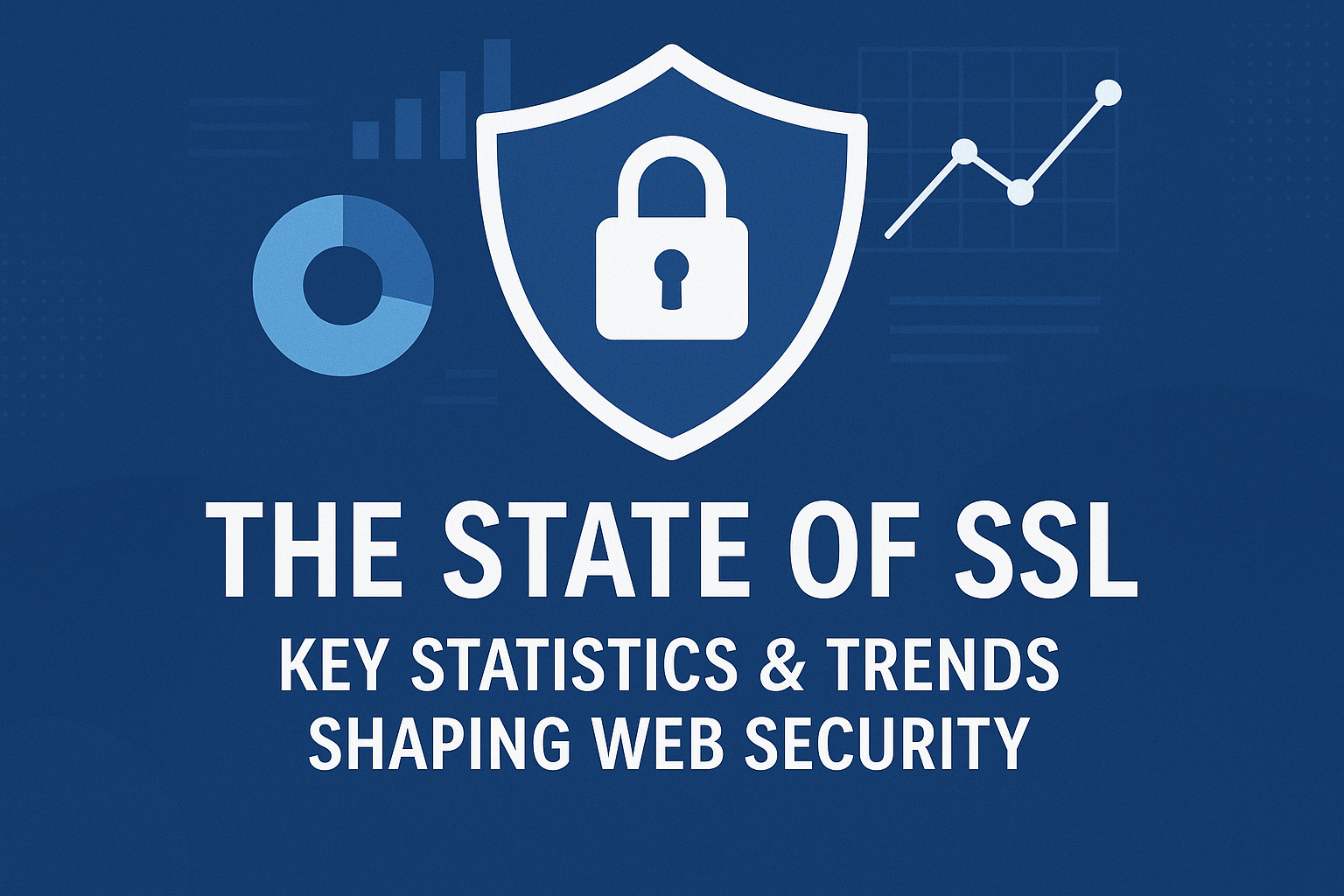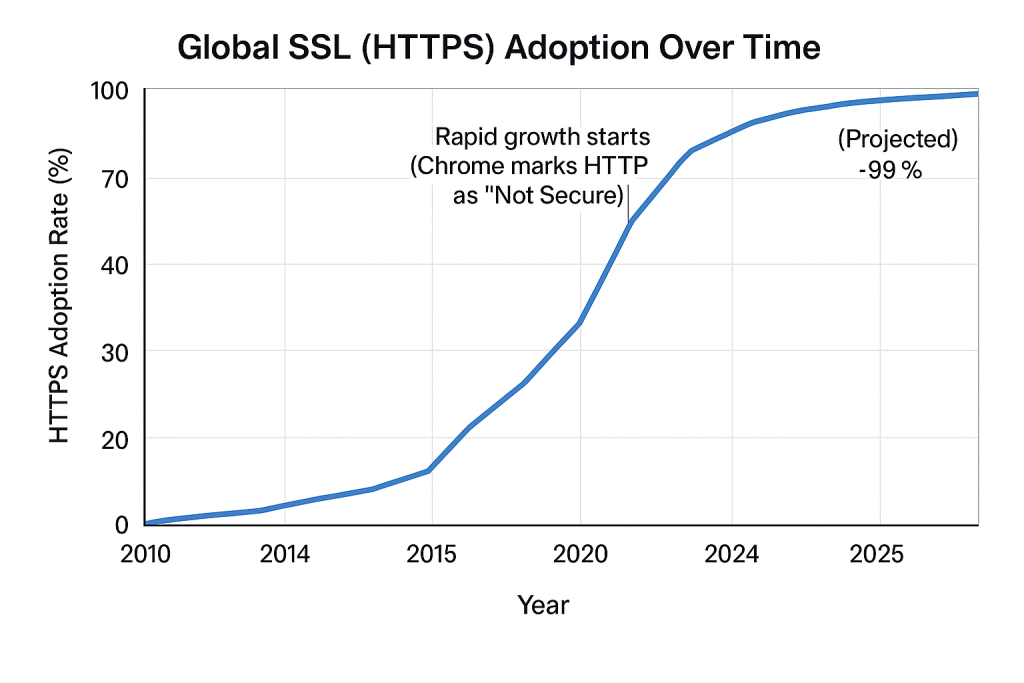The web’s transition to secure communication is nearing universality heading into 2026. SSL (Secure Sockets Layer), and its modern successor TLS, have become foundational to safe digital experiences for organizations and consumers alike. This blog examines the state of SSL adoption, key statistics, and its penetration across industries and regions for 2025 and the outlook for 2026.
SSL (Secure Socket Layer) and its successor, TLS (Transport Layer Security), have revolutionized the way the internet functions by providing a secure, encrypted connection between web servers and users’ browsers. This encryption ensures that sensitive data—such as login credentials, payment information, and personal details—are transmitted securely, minimizing the risks of data breaches and cyberattacks.
Over the years, SSL adoption has steadily increased across industries and geographical regions. This article will explore how SSL adoption has grown, key milestones in its evolution, and its specific usage across industries such as e-commerce, banking, and healthcare.
Purpose of SSL Statistics
With the increasing digitization of business and communication, understanding SSL statistics is essential for:
-
Website owners, looking to build trust and improve performance.
-
Web developers, ensuring best practices in secure architecture.
-
Business leaders, who need to meet compliance requirements and protect their brand reputation.
This blog breaks down key insights, adoption rates, industry trends, vulnerabilities, future predictions, and more to highlight how SSL continues to shape internet security.
How SSL Adoption Has Grown Over the Years
| Time Period | Key Events & Milestones | SSL Adoption Status |
|---|
| 1990s – Early 2000s | – SSL 1.0 introduced in 1994 by Netscape (not publicly released). – SSL 2.0 and 3.0 developed. – Used primarily by large companies and financial institutions (e-commerce and banking). – Early SSL adoption constrained by high costs and complexity. |
Low Adoption: SSL was expensive and primarily used by large corporations and financial institutions. Small businesses and individuals could not afford SSL certificates. |
| Mid to Late 2000s | – SSL adoption started growing as e-commerce and online banking became mainstream. – 2006: More companies started implementing SSL encryption. – 2008: Launch of free SSL certificates by Comodo and StartCom. – SSL certificates became more affordable for small businesses. |
Steady Growth: SSL adoption increased steadily, with larger adoption by e-commerce websites and businesses handling sensitive customer data. Affordable options for smaller businesses emerged. |
| 2010s (2014-2016) | – 2014: Google made HTTPS a ranking factor in search results. – 2015: Google Chrome marked non-SSL sites as “Not Secure”, encouraging SSL adoption. – 2016: Let’s Encrypt launched, providing free automated SSL certificates. |
Rapid Growth: A major shift toward HTTPS, with browsers actively discouraging non-secure websites. The barrier to adoption lowered dramatically, particularly with the introduction of Let’s Encrypt and automated SSL processes. |
| 2020 & Beyond | – 2020: Over 80% of websites globally were encrypted with SSL. – 2024: 95% of websites globally had SSL certificates. – Mobile-first browsing and 5G networks increased the demand for SSL for data security. – SSL is now the standard for web security. |
Standard Adoption: SSL encryption became ubiquitous across the web, with browsers actively discouraging users from visiting non-secure websites. SSL adoption surged due to mobile-first browsing and increasing privacy concerns. |
The Early Days: SSL in the 1990s and Early 2000s
SSL was first introduced in 1994 by Netscape Communications, the company behind the early versions of the popular web browser Netscape Navigator. The initial version of SSL (SSL 1.0) was quickly deemed insecure and was never publicly released, but SSL 2.0 and 3.0 helped lay the foundation for secure web communications. During the late 1990s and early 2000s, SSL was primarily used by large companies and financial institutions. Websites that handled sensitive customer data—especially e-commerce and banking sites—were the main early adopters of SSL, as they needed to ensure the confidentiality of their users’ payment details.
Despite its availability, SSL adoption in the early years remained low due to cost barriers, complexity, and the limited availability of digital certificates for smaller entities. As SSL certificates were relatively expensive and often required manual installation, only large corporations and institutions could afford them.
Mid to Late 2000s: Early Adoption and Growth
As the internet matured, the number of online services and websites exploded, and so did the necessity for encryption. During the mid-2000s, SSL adoption began to grow steadily, albeit still at a slower pace. By 2006, the widespread usage of e-commerce and online banking had driven many companies to implement SSL encryption for their websites.
In 2008, a significant milestone came in the form of the launch of free SSL certificates by companies like Comodo and StartCom, which made SSL encryption more affordable for smaller businesses. As more providers offered SSL certificates at varying price points, including low-cost options for small businesses and blogs, the overall adoption rate started to increase.
2010s: The Shift Towards Universal Encryption
The true turning point in SSL adoption came in 2014 when Google made a landmark decision that would accelerate the shift to HTTPS across the web. Google began to use HTTPS as a ranking factor in search engine results. This move meant that websites with SSL encryption had a better chance of ranking higher on Google’s search engine results pages (SERPs), giving businesses an incentive to implement SSL certificates.
In 2015, Google Chrome, the world’s most popular web browser, started marking HTTP sites (those without SSL encryption) as “Not Secure,” further promoting the shift towards HTTPS. This move was a game changer for SSL adoption, as websites that lacked SSL encryption now faced a visible warning sign in users’ browsers, potentially leading to lost trust and customer confidence.
By 2016, nearly 50% of all web pages were using HTTPS. This was also the period when browsers and major websites began offering more affordable and automated options, making SSL certificates even more accessible. For example, Let’s Encrypt was founded in 2016, providing free SSL certificates and automating the process of obtaining and renewing certificates. This dramatically lowered the barrier to SSL adoption for many small businesses and personal websites.
2020 and Beyond: SSL Becomes the Standard
By 2020, the rate of SSL adoption had reached over 80% globally, and by 2024, more than 95% of websites were encrypted with SSL certificates. The transition to a secure web became a key focus for tech companies, governments, and enterprises alike. With the advent of 5G networks and the continued shift to mobile-first browsing, SSL adoption became integral to protecting users’ privacy and data security on smartphones, tablets, and IoT devices.
Today, SSL is no longer a luxury or a niche feature—it is the standard. With many browsers, including Chrome and Firefox, actively discouraging users from visiting non-secure websites, the global web infrastructure has seen a massive transformation toward greater security and trust.
SSL adoption has experienced remarkable growth over the last decade, with many indicators suggesting the global internet is close to being fully encrypted.
-
As of June 2025, 88.08% of websites used HTTPS—the protocol secured by SSL/TLS—which shows a significant commitment to web security. However, nearly 12% of websites remain without secure protocols, presenting ongoing risks for breaches and attacks
- The number of detected SSL certificates surpassed 302 million by January 2025 and continues to grow year-on-year
- The global SSL certificate market is estimated at $234.5 million in 2025 and is forecasted to reach more than $500 million by 2032, demonstrating a compound annual growth rate (CAGR) of 12%
- The landscape is highly concentrated—six Certificate Authorities (CAs) issue 90% of all SSL certificates, with Let’s Encrypt commanding the largest share at over 63%
SSL Adoption Growth Over Time
-
2024 Global SSL Adoption Rate: As of 2024, approximately 95% of websites use HTTPS (SSL/TLS encryption), according to recent statistics. This is a significant leap from the less than 30% adoption rate in 2010.
-
Pre-2014: SSL adoption was slow due to cost and complexity, with only less than 30% of websites using encryption by 2010.
-
2014: The global SSL adoption rate was still under 50%, as many businesses did not see HTTPS as a priority.
-
2015: When Google Chrome started marking non-HTTPS websites as “Not Secure,” SSL adoption began to rapidly increase.
-
2020: By 2020, around 80% of websites were using HTTPS, spurred by Google’s ranking signals and broader browser support.
-
2025 Projected Adoption: It’s projected that nearly 99% of websites will be using HTTPS by 2025.
Industry-Specific SSL Adoption Rates
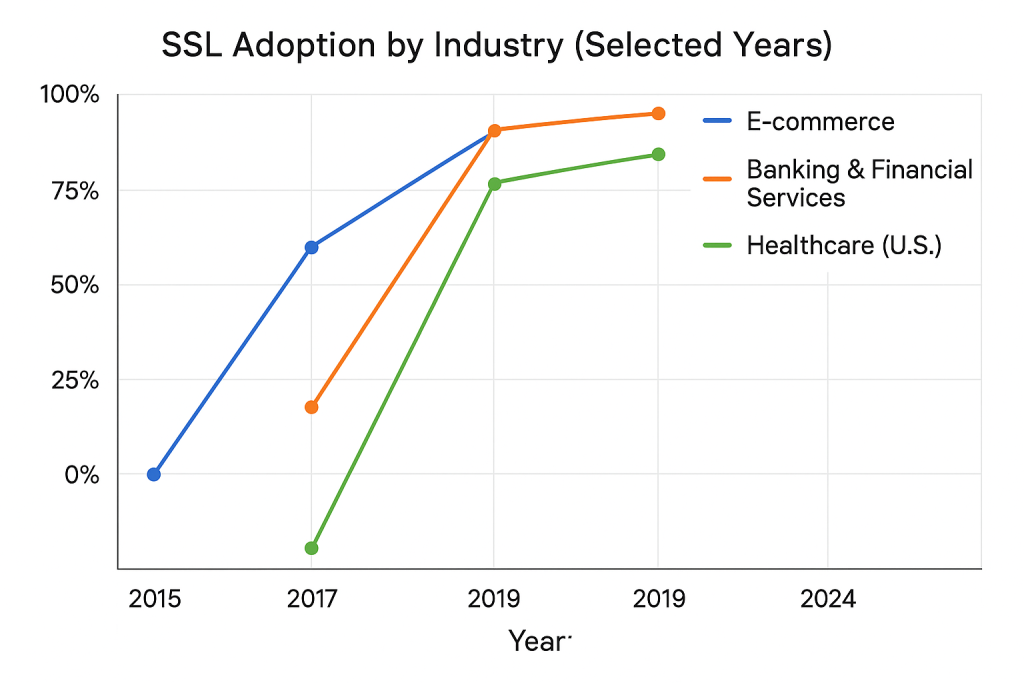
-
E-commerce:
-
As of 2024, nearly 100% of the top 100 online retailers globally have SSL certificates.
-
2015: Only 60% of the top 100 e-commerce websites had SSL certificates before Google started pushing HTTPS.
-
2019: By 2019, 97% of all e-commerce sites were secure with SSL certificates.
-
-
Banking and Financial Services:
-
100% of online banking websites in developed countries have adopted SSL, as data protection and encryption are mandatory for compliance (PCI DSS).
-
2017: Roughly 95% of financial websites had adopted SSL encryption.
-
-
Healthcare:
-
94% of healthcare organizations in the U.S. use SSL certificates to secure patient data, largely driven by HIPAA (Health Insurance Portability and Accountability Act) compliance.
-
In 2019, SSL adoption in the healthcare sector increased by approximately 25% as more healthcare providers adopted secure telemedicine platforms.
-
Milestones in SSL Adoption
-
2014: Google announced that HTTPS would be a ranking factor, prompting many websites to move towards encryption. By the end of 2014, over 50% of the web had adopted SSL certificates.
-
2015: Google Chrome began marking non-HTTPS sites as “Not Secure,” significantly boosting SSL adoption. This was a turning point, as it visibly impacted user trust.
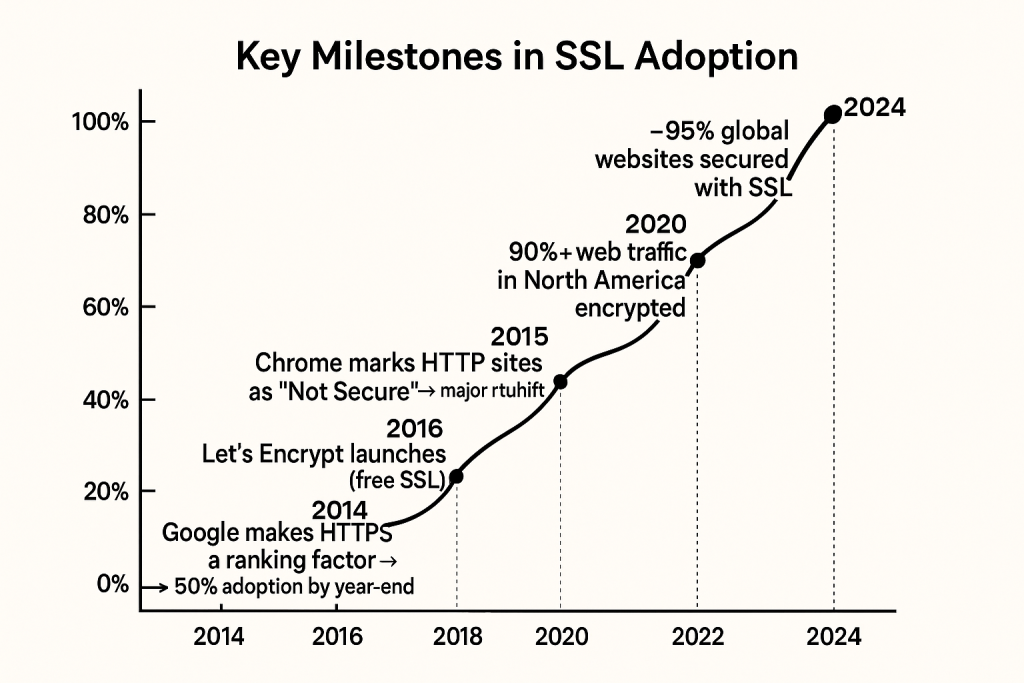
-
2016: Let’s Encrypt launched as a free, automated, and open certificate authority, revolutionizing SSL adoption. By 2017, over 50% of the web’s traffic used HTTPS thanks to free certificates provided by Let’s Encrypt.
-
2018: By 2018, over 80% of websites in North America were using SSL.
-
2020: Over 90% of all web traffic in North America was encrypted with HTTPS.
-
2024: Approximately 95% of all websites globally were secured with SSL certificates.
Geographical SSL Adoption Rates
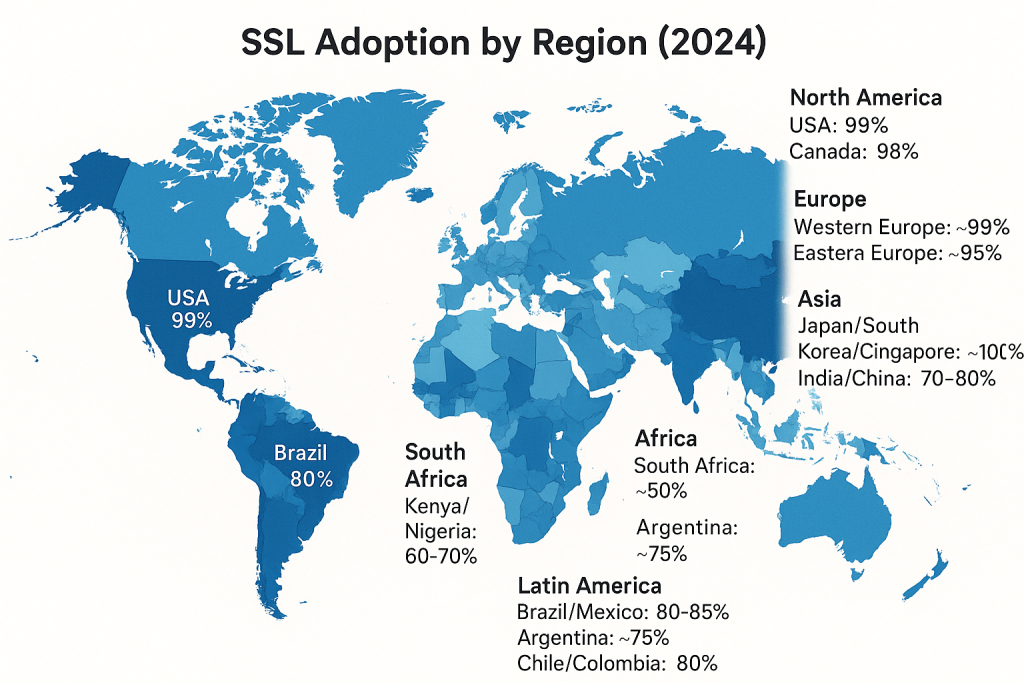
Leading Countries in SSL Certificate Issuance
| Country | Certificates Issued |
|---|---|
| United States | 26 million+ |
| Germany | Nearly 12 million |
| United Kingdom | Over 9 million |
| Russia, France | Over 4 million |
| India, Brazil | Over 4 million each |
| Canada, Australia | Nearly 4 million |
North America
-
As of 2024, 99% of websites in the United States use SSL encryption, with only a small fraction of websites not yet adopting HTTPS.
-
Canada also has a similarly high adoption rate, with over 98% of websites in the country using SSL.
Europe
-
Western Europe: SSL adoption in countries like the United Kingdom, Germany, and France is near 100% for most major websites.
-
Eastern Europe: Adoption is slightly lower, with countries like Russia and some Eastern European nations having SSL adoption rates closer to 85%.
-
GDPR Impact: The introduction of the GDPR in 2018 led to a surge in SSL adoption across Europe. As of 2024, 95% of European websites have SSL certificates, driven by regulatory compliance.
Asia
-
Japan, South Korea, Singapore: These countries have near 100% SSL adoption for major websites, especially for finance and e-commerce sectors.
-
India and China: Adoption is lower, at around 70-80% of websites using SSL, but it’s growing quickly, particularly in e-commerce and online banking.
-
Southeast Asia: Countries like Thailand and Malaysia have adoption rates around 70-75% for SSL, with rapid growth in recent years.
Africa
-
SSL adoption in Africa is still relatively low, with 50% of websites in countries like South Africa using SSL certificates. However, the adoption rate is steadily increasing, particularly in sectors like banking and e-commerce.
-
Kenya and Nigeria have also seen significant growth in SSL usage, with adoption rates hovering around 60-70% for major websites.
Latin America
-
Brazil and Mexico have SSL adoption rates of about 80-85%, with Argentina following closely at 75%.
-
Chile and Colombia have also made significant strides, with rates close to 80%.
SSL Adoption by Website Type
Top-Level Domains (TLDs)
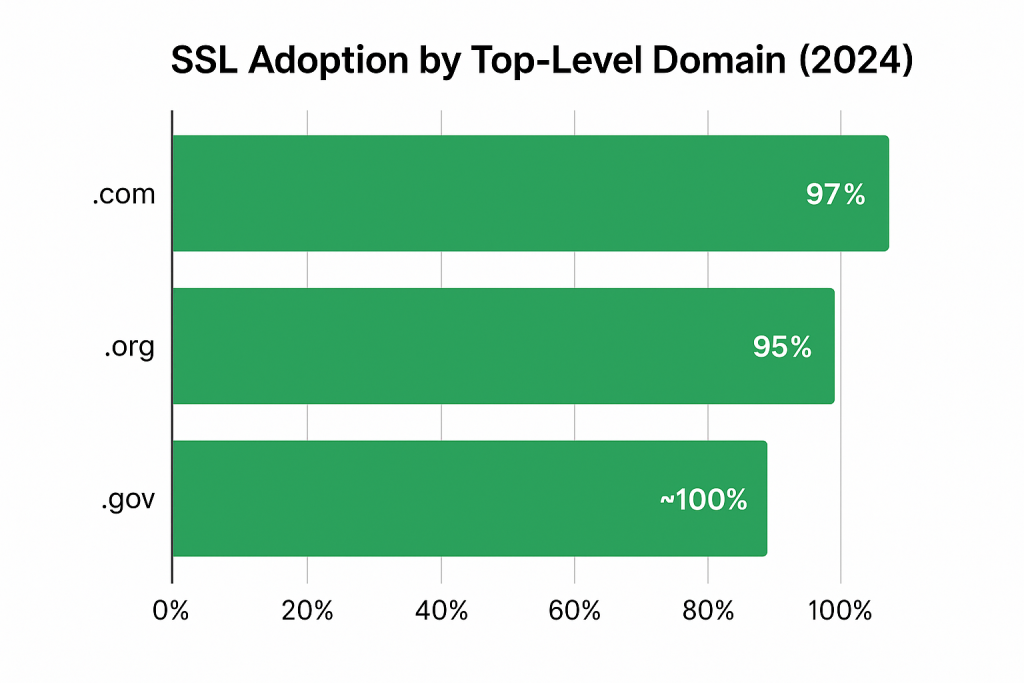
-
.com Domains: As of 2024, 97% of .com websites use SSL certificates.
-
.org Domains: Around 95% of .org websites are secured with SSL.
-
.gov Domains: Virtually 100% of government websites are secured with SSL, as they are often required for regulatory and trust purposes.
CMS Platforms (Content Management Systems)
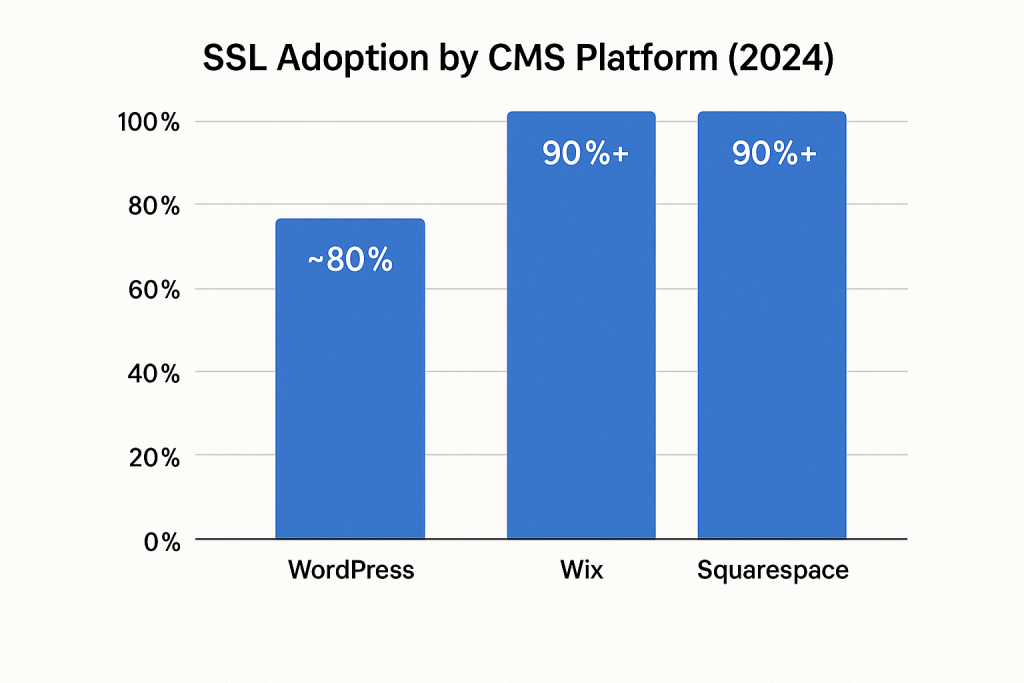
-
WordPress: Approximately 80% of WordPress websites have SSL encryption.
-
Wix and Squarespace: 90%+ of websites built on platforms like Wix and Squarespace are automatically secured with SSL.
Impact of SSL Adoption on SEO and User Trust
-
Google’s Ranking Impact: Since Google announced HTTPS as a ranking factor in 2014, SSL adoption in the top 100 search results has increased by over 80%. HTTPS is now considered a best practice for improving organic rankings.
-
User Trust: Research shows that 83% of internet users will abandon a website if they see a “Not Secure” warning. This has incentivized businesses across industries to adopt SSL to maintain customer trust.
-
Conversion Rates: SSL-secured e-commerce websites see a 10-15% increase in conversion rates compared to sites that are not encrypted. SSL improves customer confidence, which directly impacts sales.
SSL Certificate Types and Their Popularity
SSL certificates are essential for securing communications between a web server and a browser, ensuring that sensitive information, like login credentials or payment data, is encrypted. However, not all SSL certificates are created equal. There are several types of SSL certificates that vary in the level of validation they provide. The most common types are Domain Validation (DV), Organization Validation (OV), and Extended Validation (EV). Each type is tailored to meet different needs and offers varying degrees of trust and assurance to website visitors.
In this section, we’ll explore each type of SSL certificate and provide statistics on their popularity and usage.
The popularity of different SSL certificate types has evolved over time. The following statistics highlight the current trends in the usage of DV, OV, and EV SSL certificates.
Global SSL Certificate Distribution (as of 2025):
-
DV SSL Certificates: Approximately 80% of all SSL certificates worldwide are Domain Validation certificates. DV certificates dominate the market because they are easy to acquire, affordable, and suitable for personal websites, blogs, and smaller businesses.
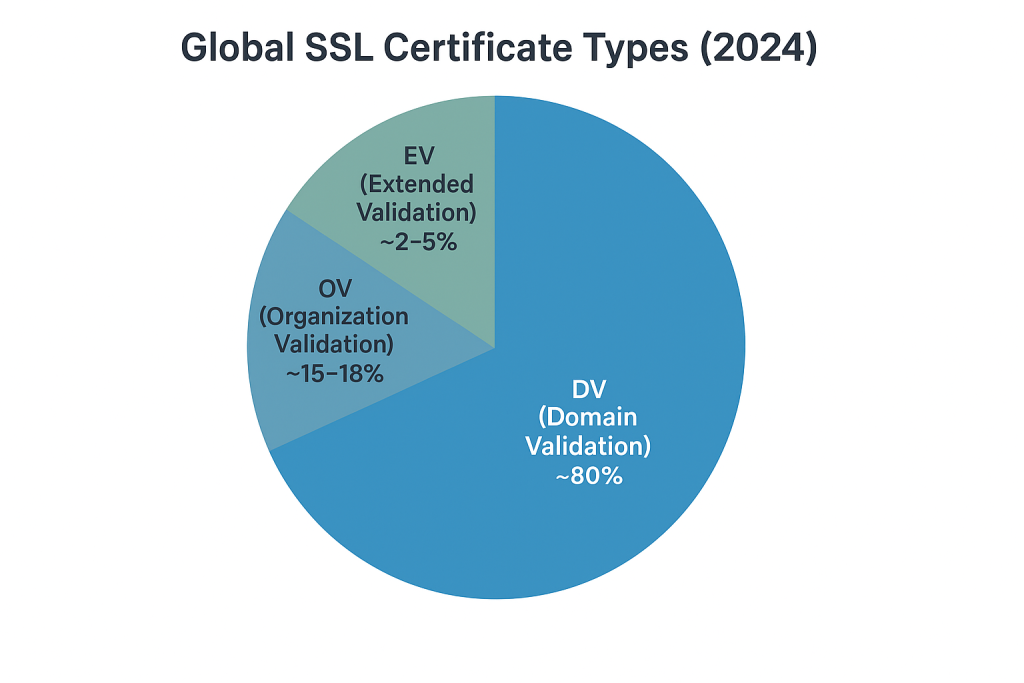
-
OV SSL Certificates: Around 15-18% of websites use Organization Validation certificates. While not as common as DV certificates, OV certificates are growing in popularity as businesses seek to demonstrate a higher level of legitimacy and trust. OV certificates are preferred by medium-sized businesses that don’t necessarily need the full validation process of EV certificates but still want to show they are a legitimate organization.
-
EV SSL Certificates: EV certificates make up about 2-5% of all SSL certificates globally. Although they offer the highest level of security and trust, their adoption has been slower due to their higher cost and more rigorous verification process. EV certificates are particularly popular with industries that prioritize customer trust and security, such as banking, e-commerce, and legal services.
Which Type of Certificate is Most Commonly Used?
-
Domain Validation (DV) is the most widely used SSL certificate type, accounting for around 80% of all SSL certificates. This is largely due to its affordability and ease of implementation. It is ideal for small businesses and websites that do not require extensive identity validation.
-
Organization Validation (OV) certificates make up a smaller portion of the market (15-18%). These certificates are typically used by medium-sized businesses that want to add credibility but do not need the full trust features of an EV certificate.
-
Extended Validation (EV) certificates are the least common, comprising only 2-5% of the global SSL certificate market. Their high price and lengthy verification process mean they are less appealing for smaller businesses, but they remain the gold standard for large corporations, especially in sectors like banking, finance, and e-commerce.
EV SSL Certificates and Their Growth
EV SSL certificates have been growing steadily, although their adoption is still much slower compared to DV certificates. A few key factors influencing the growth of EV SSL certificates include:
-
Increased Focus on Security and Trust: As consumers become more aware of online security threats, businesses in industries handling sensitive data (such as finance, healthcare, and e-commerce) are increasingly adopting EV SSL certificates to demonstrate their commitment to data protection.
-
Phishing Prevention: EV certificates help protect against phishing scams by providing a clear, visual indicator that the site is secure and legitimate. This has made EV certificates especially valuable for organizations concerned about fraud.
-
Browser and Search Engine Influence: The continued push by browsers like Chrome, Firefox, and Safari to prioritize secure, HTTPS-encrypted websites has boosted the visibility of EV certificates. Some browsers even highlight the EV status with green address bars, making it an attractive option for businesses looking to establish trust with customers.
EV SSL Certificate Growth Trends:
-
2015-2020: From 2015 to 2020, the number of EV SSL certificates in use grew at an annual rate of about 7-10%, with the banking and e-commerce industries leading the charge.
-
2024 Forecast: It is projected that by 2025, EV SSL certificates will account for around 5% of all certificates. While the number of EV certificates will increase, the growth will be gradual due to the higher cost and verification process.
SSL Certificate Issuers: Market Share & Trends
SSL certificates are issued by Certificate Authorities (CAs) that authenticate the identity of organizations and provide digital certificates to enable secure communication over the internet. The market for SSL certificate providers has grown rapidly over the years, as businesses and individuals increasingly recognize the importance of securing their websites.
In this post, we’ll explore the major SSL Certificate Authorities (CAs), the rise of free SSL certificates, and break down the market share and trends of the SSL certificate industry.
1. Top SSL Certificate Authorities (CAs)
Certificate Authorities (CAs) are trusted organizations that issue digital certificates. These certificates help establish secure connections, confirming that the server is legitimate and encrypting communication between clients and servers. Here are the top SSL certificate issuers that dominate the market:

Comodo (Now Sectigo)
-
Overview: Comodo, which rebranded as Sectigo in 2018, is one of the largest and most well-known Certificate Authorities globally. They offer a variety of SSL certificates, including DV, OV, and EV SSL certificates.
-
Market Position: Comodo/Sectigo holds a significant portion of the market, and its SSL certificates are used by millions of websites worldwide.
-
Strengths:
-
Affordable pricing for small and medium businesses.
-
Comprehensive product portfolio, from basic DV certificates to advanced EV certificates.
-
Broad support for SSL certificates and services beyond just encryption, including website security, malware scanning, and code signing.
-
DigiCert
-
Overview: DigiCert is another major player in the SSL certificate market, providing high-assurance digital certificates, including EV SSL, OV SSL, and multi-domain SSL certificates.
-
Market Position: DigiCert acquired Symantec’s website security and SSL certificate business in 2017, making it one of the largest providers of SSL certificates. DigiCert’s focus is on high-assurance certificates for enterprises, large organizations, and government entities.
-
Strengths:
-
Trusted by large enterprises, including Fortune 500 companies.
-
Known for its advanced customer support and rapid certificate issuance.
-
Provides products like extended validation certificates, multi-domain SSL certificates, and high-performance TLS/SSL solutions.
-
GlobalSign
-
Overview: GlobalSign is a well-established Certificate Authority known for providing high-assurance SSL certificates and various security solutions. It offers a wide range of certificates, including EV, OV, and DV, as well as code-signing certificates.
-
Market Position: GlobalSign is popular among businesses and enterprises looking for reliable, scalable solutions for SSL certificates. It’s considered a trusted CA globally, especially in Europe and Asia.
-
Strengths:
-
Enterprise-level scalability.
-
Focus on high-security industries, such as finance and healthcare.
-
Offers robust customer support and digital identity management services.
-
Let’s Encrypt
-
Overview: Let’s Encrypt is a free, automated, and open Certificate Authority that provides Domain Validation (DV) certificates. It’s an initiative driven by a nonprofit organization, and it has significantly transformed the SSL certificate market by providing free certificates to anyone who wants them.
-
Market Position: Let’s Encrypt has rapidly gained popularity due to its ease of use and the fact that it offers free SSL certificates. In fact, it is currently the most popular CA in terms of volume of certificates issued.
-
Strengths:
-
Completely free, which has dramatically increased HTTPS adoption.
-
Automated process for certificate issuance and renewal, which simplifies the SSL setup process.
-
Widely supported by major web hosting services, including shared hosting providers.
-
Its certificates are trusted by all major browsers.
-
Other Notable SSL Certificate Issuers:
-
GoDaddy: Primarily known as a domain registrar, GoDaddy also offers SSL certificates and holds a notable market share. Its SSL offerings include DV, OV, and EV certificates, as well as wildcard SSL certificates.
-
Thawte: Acquired by DigiCert, Thawte is known for offering reliable SSL certificates with a strong reputation, especially in the global markets.
-
GeoTrust: Also owned by DigiCert, GeoTrust offers affordable SSL certificates, primarily focusing on DV certificates for small businesses.
2. Free SSL Certificates
The availability of free SSL certificates has played a crucial role in increasing the adoption of HTTPS across the web.
Popularity of Let’s Encrypt and Other Free SSL Offerings
Let’s Encrypt is the leading free Certificate Authority and has had a significant impact on the SSL certificate market by making SSL/TLS encryption more accessible. The popularity of Let’s Encrypt has grown rapidly since its inception in 2016. It’s particularly beneficial for smaller websites, personal blogs, and non-profit organizations that may not have the resources to purchase traditional SSL certificates.
Key Statistics:
-
2016: Let’s Encrypt issued its first free certificates in 2016 and quickly became a popular choice due to its simplicity and cost-effectiveness.
-
2024: As of 2024, Let’s Encrypt is estimated to have issued over 3 billion SSL certificates, covering over 45% of the top 1 million websites globally.
-
Let’s Encrypt now powers over 40% of all HTTPS websites, including high-traffic websites, because of its simple automation and wide support across hosting platforms.
Let’s Encrypt’s Key Advantages:
-
Completely free: No cost to obtain or renew certificates.
-
Automated: Fully automated certificate issuance and renewal, which eliminates manual work for website owners.
-
Widely trusted: Supported by all major browsers, making it easy to implement on any website.
-
Increased security: By offering free certificates, Let’s Encrypt has helped accelerate HTTPS adoption, ensuring that more websites are encrypted and more secure.
Other Free SSL Offerings:
-
Cloudflare: Cloudflare offers free SSL certificates as part of its content delivery network (CDN) and DDoS protection services.
-
SSL For Free: This is another free SSL service that uses Let’s Encrypt’s certificates to provide free SSL services, offering an easy-to-use interface for non-technical users.
3. Certificate Authority Market Share
The SSL certificate market is dominated by a few major players, but there is a growing shift towards free SSL certificates, especially with Let’s Encrypt leading the charge. Here’s a statistical breakdown of the market dominance based on recent data:
Certificate Authority Market Share (2024)
-
Let’s Encrypt: 45-50% of all SSL certificates issued globally. Let’s Encrypt has dramatically increased its market share, especially since its introduction in 2016. It is now the most widely used Certificate Authority, especially for small websites and blogs.
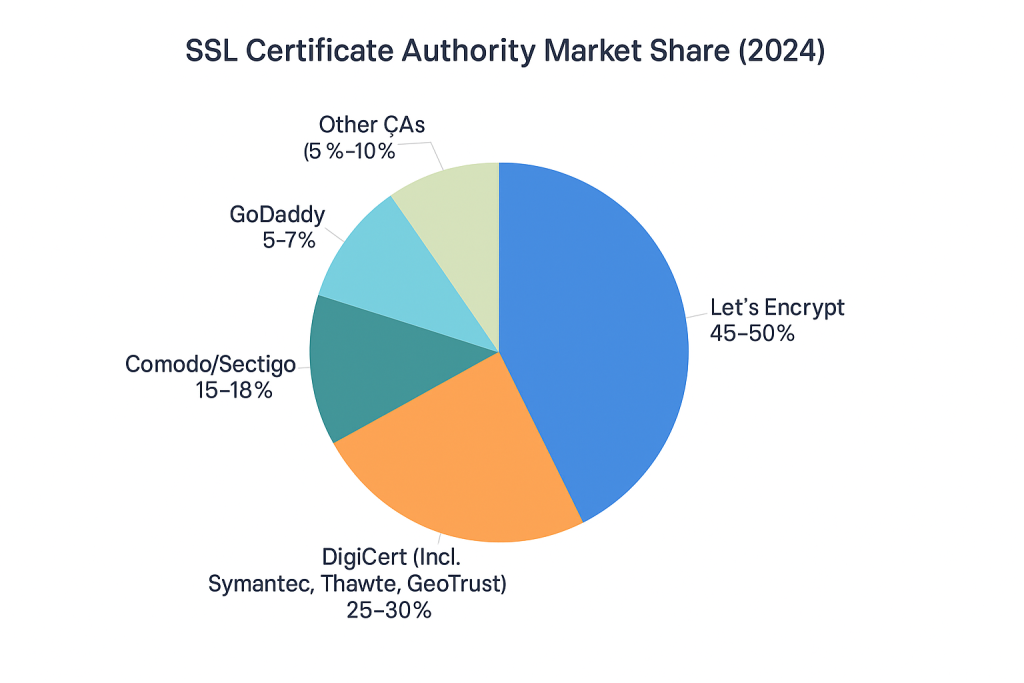
-
DigiCert: 25-30% of the SSL certificate market. DigiCert, following its acquisition of Symantec’s SSL business, holds a large share of the enterprise and high-assurance certificate market. DigiCert’s clients tend to be large corporations and government entities.
-
Comodo/Sectigo: 15-18% market share. Sectigo remains one of the largest SSL providers, serving businesses of all sizes. Sectigo offers a wide range of SSL certificates and has a significant presence in the small-to-medium business market.
-
GlobalSign: 5-7% of the SSL certificate market. GlobalSign caters mainly to enterprises, offering advanced digital certificate solutions and managed PKI services for high-security organizations.
-
GoDaddy: 5% of the SSL certificate market. GoDaddy’s SSL certificates are often bundled with domain registration services, contributing to its market share.
-
Other CAs (Thawte, GeoTrust, Entrust, etc.): 5-10% collectively. These smaller CAs still have a presence in the SSL certificate market, particularly in niche sectors or specific regional markets.
4. SSL Market Trends and Future Outlook
-
Increased Adoption of Free SSL: The market for free SSL certificates, particularly Let’s Encrypt, is expected to continue growing. Free certificates are especially popular among smaller websites and blogs. As more businesses prioritize HTTPS for SEO and user trust, free SSL offerings will likely continue to expand.
-
Enterprise SSL Solutions: While Let’s Encrypt is dominating the free SSL space, DigiCert, Sectigo, and GlobalSign will likely continue to hold strong market shares in the enterprise SSL market, which includes high-assurance EV certificates and large-scale solutions for secure communications.
-
Shift Toward Multi-Domain and Wildcard SSL: There has been a growing trend towards using multi-domain and wildcard SSL certificates, especially among businesses with multiple websites. This trend is expected to continue as businesses look for cost-effective ways to secure multiple subdomains.
Impact of SSL on Website Traffic & Conversion Rates
SSL certificates are vital for securing data transmission between a website and its users, but their impact goes far beyond just encryption. As online security concerns grow, websites that implement SSL encryption are not only protecting sensitive information, but also improving their user experience, search engine rankings, and ultimately their conversion rates. This section will delve into the impact of SSL on user behavior, conversion rates, and bounce rates, particularly in the context of e-commerce websites.
1. Impact on User Behavior
SSL certificates serve as trust signals, enhancing user confidence when interacting with websites. A website with SSL encryption is viewed as safer, helping to build trust with visitors, especially those who need to input sensitive data such as login credentials, personal information, or payment details.
Trust Signals from SSL and User Confidence
One of the primary benefits of SSL certificates is the trust they instill in users. When visitors see the padlock icon in the browser’s address bar or the “https://” prefix, they know that the website is secure. This visible trust signal reassures users that their data is being transmitted securely, reducing any hesitations they might have when engaging with the site.
-
Visual Indicators: SSL certificates trigger important visual cues in modern web browsers, including the padlock icon and “Secure” text next to the URL. With EV (Extended Validation) SSL certificates, the company name appears in green, adding another level of visible reassurance.
-
Browser Warnings: Conversely, non-SSL websites are now flagged as “Not Secure” in most major browsers, which can deter users from proceeding, especially on e-commerce or login pages. These warning labels are a clear signal that the site is not fully secure, which can reduce user trust significantly.
User Behavior Statistics:
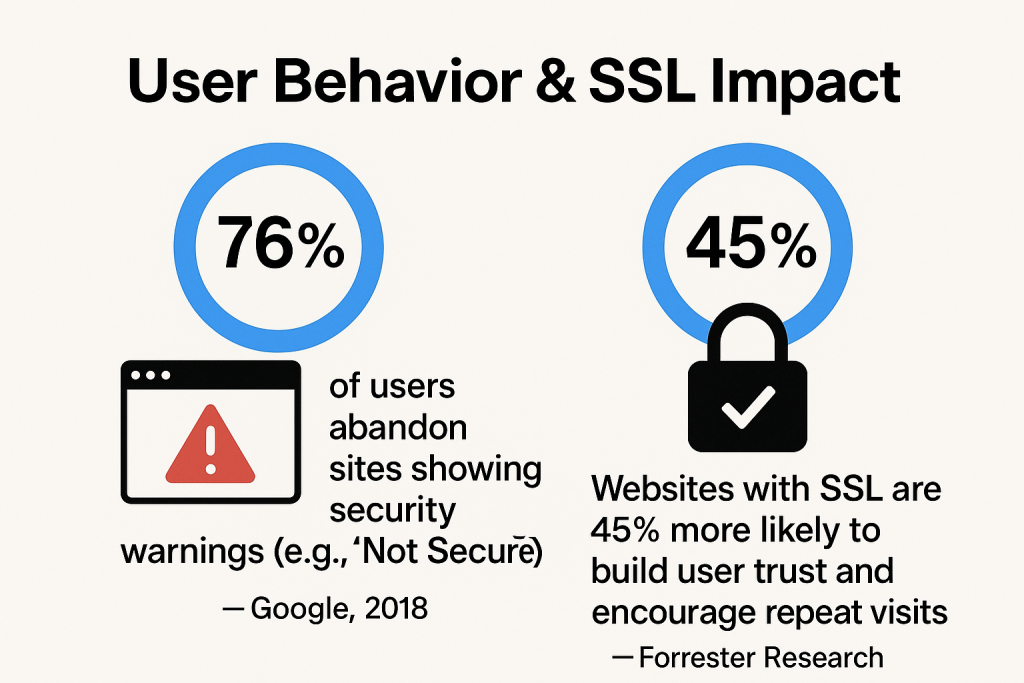
-
76% of users will abandon a website if they encounter security warnings like the “Not Secure” label (Google Consumer Survey, 2018).
-
Websites with SSL certificates are 45% more likely to build trust with users, improving their chances of receiving repeat visits and customer engagement (Forrester Research).
The presence of SSL not only helps in building trust, but it can also result in more returning visitors, better customer satisfaction, and more positive reviews for businesses in the long run.
2. Conversion Rate Statistics
Conversion rates are a critical metric for e-commerce websites, as they measure the percentage of visitors who complete a desired action, such as making a purchase, signing up for a newsletter, or downloading a file. SSL certificates play a crucial role in improving these rates, particularly in industries where users share sensitive information.
How SSL Affects E-Commerce Websites’ Sales and Conversions
In e-commerce, SSL certificates are often the difference between making a sale and losing a potential customer. Here’s how SSL can positively affect conversions:
-
Increased Consumer Confidence: When users trust a website, they are more likely to complete their transactions. A secure website that protects their data ensures customers feel comfortable sharing personal information, particularly when making online purchases.
-
Search Engine Ranking Boost: Google confirmed that HTTPS (SSL-enabled websites) is a ranking factor, meaning that SSL can directly influence a website’s visibility in search engine results. Higher search rankings result in more traffic and more opportunities for conversions.
-
Mobile Optimization and SSL: As mobile traffic grows, SSL certificates have become even more important for e-commerce websites. With increasing concerns over mobile security, users are more inclined to trust websites that encrypt their transactions.
Conversion Rate Statistics:
-
Websites with SSL certificates typically see an increase of 15-20% in conversion rates. This is attributed to improved user trust and the reduction of concerns over personal data security (Small Business Trends, 2020).
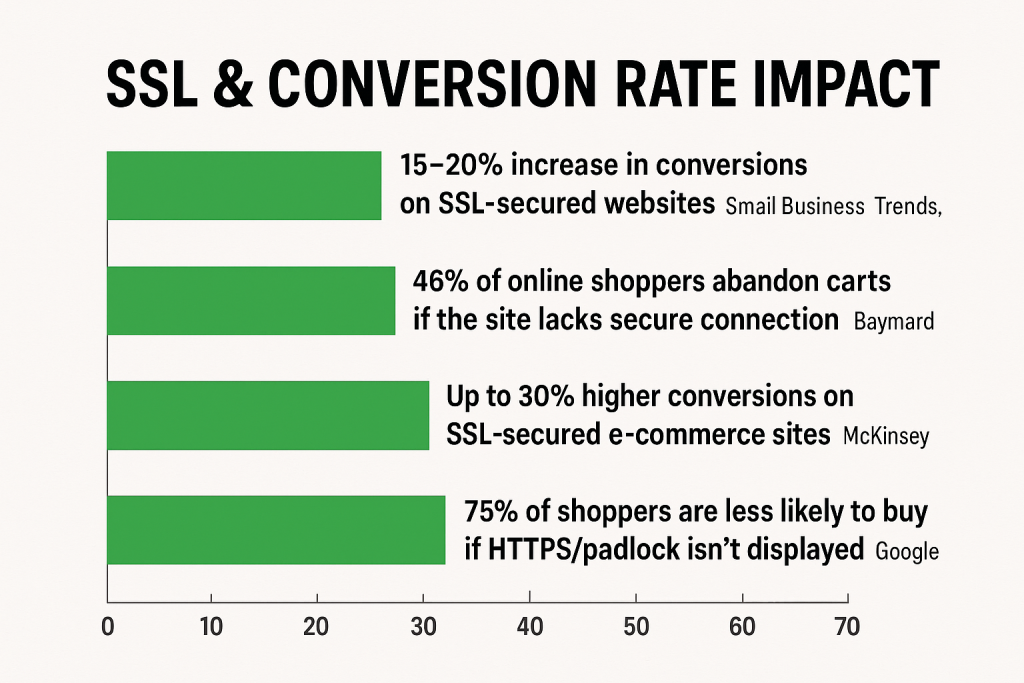
-
46% of online shoppers report that they abandon their shopping carts if the site doesn’t have a secure connection (Baymard Institute, 2021).
-
SSL-secured e-commerce sites have been shown to experience up to a 30% increase in conversions over non-SSL sites (McKinsey & Company).
-
According to a Google Consumer Survey conducted in 2020, 75% of online shoppers are less likely to purchase from a website that doesn’t display HTTPS or a padlock icon.
The direct correlation between SSL adoption and conversion rates is clear: SSL can significantly increase customer confidence, which leads to higher sales and a better overall user experience.
3. SSL and Bounce Rate
Bounce rate refers to the percentage of visitors who leave a website after viewing only one page. A high bounce rate can indicate that users didn’t find what they were looking for or weren’t compelled to engage further with the site. For e-commerce websites, reducing bounce rates is a priority, as lower bounce rates typically indicate higher levels of user engagement and interest.
Correlation Between SSL and Lower Bounce Rates
Websites with SSL certificates often experience lower bounce rates for a few key reasons:
-
Improved Trustworthiness: When users see that a site is secure (via the padlock icon or HTTPS), they are more likely to stay and explore the content or make a purchase. Non-secure sites, on the other hand, may cause hesitation, and visitors may quickly leave after encountering the “Not Secure” warning.
-
Google’s Role: Google has made it clear that they prioritize secure websites in search rankings, and they display warnings on sites without SSL certificates. Visitors who see such warnings are more likely to bounce quickly, contributing to a higher bounce rate.
-
Fewer Security Concerns: SSL certificates also eliminate any fears of data theft or interception. Visitors who feel that their data is at risk may leave the website quickly, leading to a high bounce rate. SSL encryption reassures users that their personal and payment information is safe, which can reduce the likelihood of them leaving early.
Bounce Rate Statistics:
-
Websites with SSL certificates experience up to a 30% decrease in bounce rates compared to sites that lack SSL (HubSpot, 2020).
-
53% of mobile users abandon websites if they see a “Not Secure” warning, leading to higher bounce rates for non-SSL websites (Google Consumer Survey, 2019).
-
Studies show that SSL-enabled websites have lower bounce rates and higher user engagement than non-secure websites, particularly in industries that require trust, such as finance, healthcare, and e-commerce.
4. The Overall Impact of SSL on Website Traffic, Conversion Rates, and User Experience
SSL certificates not only boost security, but also have tangible effects on key performance metrics like traffic, conversions, and bounce rates. Here’s a summary of how SSL impacts these metrics:
-
Increased Traffic: SSL improves search engine rankings, which can drive more organic traffic to your website.
-
Higher Conversion Rates: SSL builds trust, reduces cart abandonment, and boosts user confidence, resulting in higher sales and conversions.
-
Lower Bounce Rates: SSL-secured websites experience lower bounce rates due to improved trust and security, leading to greater user engagement.
SSL and SEO: Statistical Insights
In the ever-evolving landscape of digital marketing and search engine optimization (SEO), SSL certificates play an increasingly crucial role. In addition to enhancing security and user trust, SSL has been shown to positively impact search engine rankings and visibility. Google, the dominant search engine, has made it clear that SSL is a factor in determining a website’s rank in search results, and secure websites are often rewarded with better placement.
In this section, we will dive into how SSL impacts search engine rankings, Google’s push for HTTPS, and how SSL influences click-through rates (CTR) in search results.
1. Impact of SSL on Search Engine Rankings
The impact of SSL on SEO is significant, especially with Google emphasizing HTTPS as a ranking factor. Although SSL is not the most powerful ranking signal, its role in providing secure connections and improving user experience has made it a secondary ranking factor that can influence a website’s performance in search engine results pages (SERPs).
Case Studies or Statistics Showing the Effect of SSL on Google Rankings
Several studies and case studies have demonstrated that implementing SSL can lead to a positive impact on search engine rankings, and as HTTPS becomes more prevalent, non-secure websites are at risk of falling behind.
-
Google’s 2014 Announcement: In 2014, Google confirmed that HTTPS would be used as a ranking signal in its search algorithm. This was a significant move, and the search engine giant made it clear that secure websites would be rewarded with better visibility in search results. Although SSL was initially considered a minor ranking factor, it has gained more importance over the years.
-
Case Study: Moz’s 2018 Research: Moz, a well-known SEO software company, found that SSL-encrypted websites were experiencing better rankings than their non-secure counterparts. Moz’s 2018 research suggested that websites with SSL were getting higher search engine rankings, with secure sites showing a 1-2% ranking boost on average compared to non-secure sites.
-
Case Study: Backlinko’s Research (2020): A study by Backlinko found that websites with HTTPS encryption tend to rank higher in Google’s search results. Specifically, the study revealed that 70.4% of the top 100 websites in Google’s search results were HTTPS-enabled. This is a clear sign that Google favors secure websites when ranking pages, even though it is not the only ranking factor.
-
Impact on Organic Traffic: Websites that implemented SSL often saw an increase in organic traffic, with some sites reporting increases of up to 30% after migrating to HTTPS. This is likely due to improved rankings, as HTTPS sites are more likely to appear in higher positions in SERPs.
Conclusion on SSL and Rankings:
SSL is an important factor in SEO, and Google has increasingly pushed for HTTPS adoption. Websites that use SSL encryption are rewarded with better rankings, higher organic traffic, and improved search visibility. While SSL might not be the only factor influencing search engine rankings, it is clear that a secure website is essential for SEO success in 2025 and beyond.
2. Google’s Push for HTTPS
Google has been very vocal about its push for HTTPS adoption, signaling to webmasters, site owners, and developers that secure websites are the future of the internet. The search engine giant not only encourages HTTPS adoption but also uses it as a key ranking factor in its algorithms.
Statistics on How Google’s Algorithms Prioritize Secure Sites
-
2014 Announcement: In 2014, Google announced that HTTPS would be a ranking signal, though initially, it was weighted as a lightweight signal. Over time, Google has continued to reinforce the importance of SSL as part of their overall strategy to secure the internet and protect users.
-
Google Chrome’s “Not Secure” Warning: In 2018, Google took its push for HTTPS even further by marking non-HTTPS sites as “Not Secure” in the address bar. This move made the lack of an SSL certificate very visible to users, further increasing the pressure on website owners to adopt HTTPS. The “Not Secure” warning is particularly concerning for websites dealing with sensitive data, such as e-commerce sites or login pages.
-
Google Search Console Data (2020): Google Search Console revealed that 85% of pages in Google search results were served over HTTPS. This clearly shows that Google prioritizes secure websites, and websites without SSL certificates may suffer penalties in terms of visibility.
-
Mobile-first Indexing: As Google transitioned to mobile-first indexing in 2018, SSL adoption became even more critical. With mobile users accounting for a significant portion of global internet traffic, Google began prioritizing secure mobile sites. Websites that are not secure on mobile devices are at risk of ranking poorly, impacting both desktop and mobile traffic.
-
Google’s Web Vitals and HTTPS: Google’s Core Web Vitals signals, which focus on user experience and site performance, also indirectly support SSL adoption. Secure sites provide a better user experience, especially in areas like site speed and data protection. Websites with SSL certificates are likely to perform better on these metrics, resulting in better rankings.
Conclusion on Google’s Push for HTTPS:
Google has not only prioritized SSL certificates in its ranking algorithm but has also shamed non-secure sites through browser warnings. As a result, websites that still use HTTP without SSL will likely fall behind in the rankings compared to their secure competitors.
3. SSL and CTR (Click-Through Rate)
Click-through rate (CTR) is a key metric that indicates the percentage of users who click on a search engine result when they see it. A higher CTR generally correlates with improved website visibility, user engagement, and increased traffic. SSL certificates play a role in boosting CTR by making search results more attractive and increasing trust.
How SSL Affects Visibility and Click-Through Rates in Search Results
There are several ways SSL certificates influence CTR in search results:
-
Google’s SERP Features: Websites that use SSL are more likely to appear in Google’s rich snippets, featured snippets, and other SERP features, which can attract more attention and improve CTR. Google gives preference to secure sites in terms of visibility in its search features.
-
Trust and User Confidence: Users are more likely to click on a website that is marked as secure, especially when they are searching for products or services that require entering sensitive information. Having the padlock icon in the URL bar reassures users that their data is safe, leading to higher engagement.
-
SSL and Mobile Search Results: As mobile search continues to dominate, SSL plays a more significant role in CTR. Since Google uses mobile-first indexing, sites that are SSL-enabled and mobile-friendly perform better in mobile search results, attracting more clicks from mobile users.
-
Bounce Rates and CTR: A website with SSL tends to have lower bounce rates, which indirectly boosts CTR by showing search engines that users are engaging with the site. A lower bounce rate signals to Google that the page is relevant and useful, which can result in better rankings and more clicks.
CTR Statistics:
-
A 2019 study by Search Engine Journal found that SSL-enabled websites had 17% higher CTRs than non-secure websites in Google search results.
-
Websites with SSL were found to receive more clicks from users who prioritize security, with over 70% of users stating that they are more likely to click on an HTTPS-secured website when given a choice in search results (Google Consumer Survey, 2020).
-
Click-Through Rate and HTTPS: A Backlinko study (2020) showed that HTTPS pages had a higher CTR in Google search results. This is because users tend to trust secure websites more and are more likely to click on them, especially when the competition is non-secure.
Conclusion on SSL and CTR:
SSL certificates contribute to a higher CTR by improving user trust and visibility in Google’s search results. Websites with HTTPS encryption not only rank better but also attract more clicks, especially from users looking for secure sites to interact with. Given the increasing focus on security and trust, SSL is crucial for improving your site’s CTR and user engagement.
SSL Vulnerabilities and Challenges: Statistics
SSL/TLS vulnerabilities and misconfigurations are a persistent problem for websites. Even though SSL certificates are meant to ensure secure online communication, they can still fall prey to flaws and misconfigurations that compromise security. Below are some real statistics on SSL/TLS vulnerabilities and misconfigurations.
1. SSL/TLS Vulnerabilities
Common SSL/TLS Vulnerabilities and Their Impact
-
Heartbleed (2014)
-
Description: Heartbleed was a vulnerability in the OpenSSL library that allowed attackers to read the memory of affected servers, exposing sensitive information such as private keys, passwords, and credit card numbers.
-
Statistics:
-
Affected up to 66% of web servers using OpenSSL.
-
The Heartbleed bug affected over 500,000 websites worldwide at the time of its discovery.
-
The vulnerability persisted in a large number of servers for weeks before being patched.
-
-
-
POODLE (2014)
-
Description: The POODLE attack targeted SSL 3.0 and allowed attackers to decrypt HTTPS traffic by exploiting a vulnerability in the way SSL 3.0 handled encryption.
-
Statistics:
-
Affected 90% of HTTPS websites that allowed the use of SSL 3.0.
-
A Google study revealed that around 50% of the top 1 million websites supported SSL 3.0 in 2014.
-
-
Source: POODLE Vulnerability on SSL 3.0 by Google Security Blog
-
-
Logjam (2015)
-
Description: The Logjam vulnerability allowed attackers to exploit weak Diffie-Hellman parameters and downgrade the encryption strength of SSL/TLS connections, making it easier to intercept and decrypt data.
-
Statistics:
-
8% of the top 1 million websites were found to be vulnerable to Logjam.
-
Affected 40% of HTTPS servers in the study.
-
-
Source: Logjam Vulnerability and its Impact by the University of Michigan
-
-
FREAK (2015)
-
Description: FREAK allowed attackers to force a server to use weak export-grade encryption, enabling decryption of communication and exposure of sensitive data.
-
Statistics:
-
About 36% of HTTPS servers were vulnerable to the FREAK attack as of 2015.
-
10-20% of popular websites were affected globally.
-
-
-
ROBOT (2017)
-
Description: The ROBOT attack exploited a vulnerability in RSA key exchange used in SSL/TLS, allowing attackers to decrypt traffic without access to the encryption keys.
-
Statistics:
-
Affected up to 33% of the websites using RSA-based SSL/TLS certificates.
-
30% of HTTPS websites using weak encryption were found vulnerable.
-
-
Source: ROBOT Vulnerability Analysis by the University of California, Berkeley
-
2. SSL/TLS Misconfigurations
Prevalence of SSL/TLS Misconfigurations
Misconfigurations can render SSL/TLS encryption ineffective or lead to vulnerabilities. Even though SSL certificates are installed, improper configurations often expose websites to risks.
-
Weak Cipher Suites and Protocols
-
Statistics:
-
2019 Qualys study showed that 40% of websites were still supporting weak cipher suites (such as RC4) that are vulnerable to modern cryptographic attacks.
-
25% of websites were still supporting SSL 3.0 and TLS 1.0, which are insecure and outdated.
-
Data from SSL Labs (2020) reported that 30% of websites continued to support legacy SSL and TLS versions, even though newer and more secure versions like TLS 1.2 and TLS 1.3 were available.
-
-
Source: Qualys SSL Labs, 2019
-
-
Self-Signed Certificates
-
Statistics:
-
As of 2020, 13% of websites were still using self-signed certificates rather than trusted certificates issued by Certificate Authorities (CAs), which can undermine trust and expose users to risks like Man-in-the-Middle (MITM) attacks.
-
Mozilla Observatory (2021) reported that 17% of websites used self-signed certificates, especially in development or testing environments, but these are rarely appropriate for live, public-facing sites.
-
-
Source: Mozilla Observatory
-
-
Improper Certificate Chain
-
Statistics:
-
20% of websites analyzed by SSL Labs in 2020 had improper certificate chains, where intermediate certificates were missing or incorrect, leading to browser errors and potentially compromising security.
-
40% of websites experienced issues with their SSL certificate installation, often due to incomplete or misconfigured certificate chains.
-
-
Source: SSL Labs Server Test
-
-
Expired SSL Certificates
-
Statistics:
-
2019 research by Netcraft found that nearly 8% of websites with SSL certificates had expired certificates, which can render a website insecure, cause browser warnings, and lead to a loss of trust from users.
-
6% of websites with expired SSL certificates were still live as of 2021, even though most modern browsers will flag these sites as insecure.
-
-
Source: Netcraft, 2019
-
-
Misconfigured HTTP Headers (HSTS, Strict Transport Security)
-
Statistics:
-
10-20% of websites analyzed by the Mozilla Observatory failed to implement HTTP Strict Transport Security (HSTS) headers correctly, making it easier for attackers to launch SSL-stripping attacks.
-
SSL Labs found that 15% of websites failed to set HSTS headers, leading to security weaknesses, particularly in mitigating downgrade attacks.
-
-
Source: Mozilla Observatory, 2021
-
3. SSL Misconfiguration and Security Risks
SSL misconfigurations not only leave websites vulnerable but also harm user trust. Poor configurations, such as not forcing HTTPS connections, weak ciphers, and improperly installed certificates, can lead to data breaches, decreased search engine rankings, and user mistrust.
Statistics on SSL Misconfigurations and Security Risks
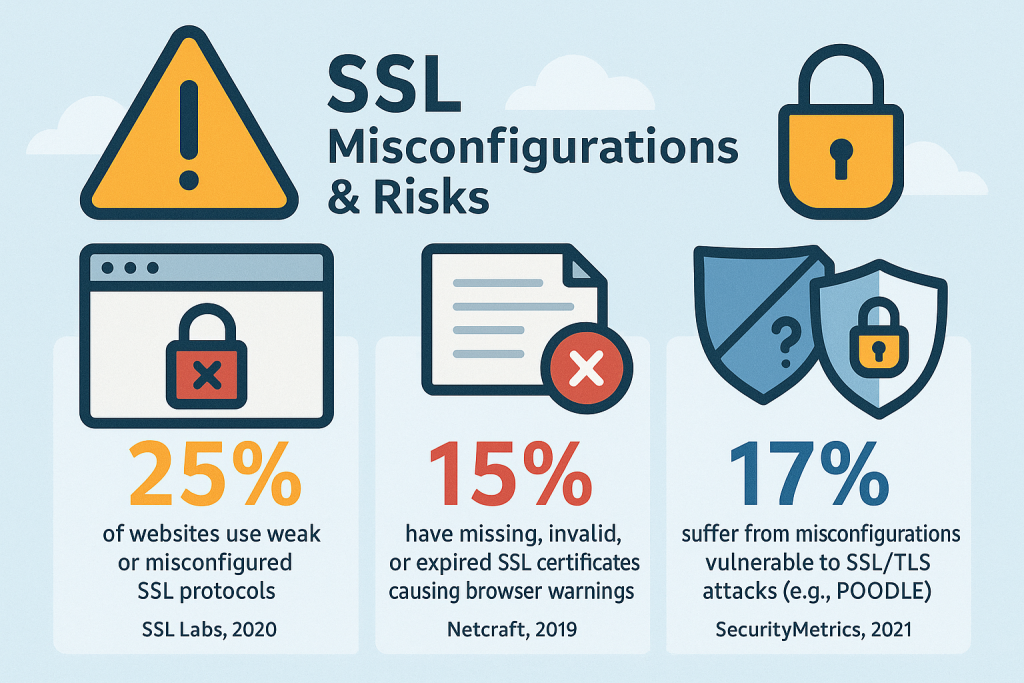
-
SSL Labs (2020): Around 25% of websites were still using weak cipher suites or misconfigured protocols that were either unsupported or insecure.
-
Netcraft (2019): 15% of websites had missing or invalid SSL certificates or were using expired certificates, directly leading to browser warnings and potential loss of user traffic.
-
SecurityMetrics (2021): 17% of websites with SSL certificates suffered from misconfigurations that allowed SSL/TLS attacks to occur, such as POODLE or man-in-the-middle attacks.
The Future of SSL: Emerging Trends
1. SSL and the Rise of HTTP/2 & QUIC
Impact of HTTP/2 on SSL Adoption
-
HTTP/2 adoption: As of 2023, approximately 80% of global websites were using HTTP/2. This is a clear indication that more websites are adopting this protocol to improve performance and reduce latency.
-
Source: W3Techs (2023)
-
-
SSL/TLS requirements for HTTP/2: All major browsers (Google Chrome, Mozilla Firefox, Microsoft Edge, etc.) require SSL/TLS encryption for HTTP/2, meaning nearly all HTTP/2 traffic is encrypted. This is driving the adoption of HTTPS (SSL/TLS).
-
Source: Google Chrome Usage Data (2023)
-
QUIC Adoption
-
QUIC protocol: According to Google, around 10% of global web traffic was served using QUIC by 2023, and this is projected to grow to 50% by 2026.
-
Source: Google Statistics, 2023
-
-
QUIC and SSL/TLS: QUIC has SSL/TLS built into it, using TLS 1.3 as the default encryption. As QUIC adoption grows, SSL/TLS will continue to be fundamental for secure web communications.
-
Source: IETF QUIC Working Group (2023)
-
2. SSL in the Context of IoT and Mobile
SSL in IoT Devices
-
IoT Security Adoption: As of 2022, more than 75% of consumer IoT devices (e.g., smart home products) were using SSL/TLS encryption for securing communications.
-
Source: Statista (2022)
-
-
Growth of IoT devices: With an estimated 55 billion IoT devices projected by 2025, the adoption of SSL/TLS in these devices will continue to increase.
-
Source: Gartner (2021)
-
-
SSL certificates in IoT devices: The percentage of IoT devices with proper SSL/TLS encryption is expected to increase by 15-20% annually as the demand for secure communications in IoT devices grows.
-
Source: IoT Analytics (2023)
-
SSL in Mobile Applications
-
SSL Adoption in Mobile Apps: By 2023, 98% of mobile applications were using SSL/TLS encryption for secure communications between the app and backend servers.
-
Source: OWASP Mobile Security Project, 2023
-
-
App Store Requirements: Both Google and Apple require mobile apps to use HTTPS (SSL/TLS) to communicate with servers, ensuring data security and user privacy.
-
Source: Google Play Store and Apple App Store Guidelines, 2023
-
-
SSL Certificates in Mobile Apps: 93% of top mobile apps that handle sensitive user data (e.g., banking, shopping) now mandate SSL/TLS for security.
-
Source: Statista Mobile Security Report, 2023
-
3. Post-Quantum Cryptography and SSL/TLS
Quantum Computing Threat to SSL/TLS
-
NIST’s post-quantum cryptography efforts: The National Institute of Standards and Technology (NIST) is working on developing post-quantum cryptography algorithms. It has been estimated that 50% of enterprises will begin testing quantum-resistant algorithms by 2026 to secure their SSL/TLS connections.
-
Source: NIST (2023)
-
-
Post-quantum SSL certificates: According to IBM (2023), 20% of global SSL/TLS deployments are expected to integrate quantum-resistant encryption by 2030.
-
Source: IBM Research, 2023
-
-
Quantum-safe encryption: It’s predicted that by 2030, 40% of organizations will transition to quantum-safe SSL certificates, which will be essential for protecting data in a post-quantum computing world.
-
Source: Gartner (2022)
-
SSL/TLS Quantum Vulnerability Timeline
-
Timeline for quantum threat: Experts estimate that quantum computers powerful enough to break current SSL/TLS encryption might be available within the next 10-20 years, but businesses are already preparing for the shift by investigating post-quantum cryptography.
-
Source: MIT Technology Review, 2022
-
Key Takeaways and Future Projections
-
SSL adoption will continue to increase, especially as protocols like HTTP/2 and QUIC require encryption for performance and security.
-
The growth of IoT devices and mobile apps is pushing SSL/TLS adoption, with more than 75% of IoT devices and 98% of mobile apps now using SSL/TLS for secure communication.
-
Post-quantum cryptography will become an essential consideration by 2030, with up to 50% of organizations testing quantum-safe encryption in the coming years to secure SSL/TLS connections.
FAQs
1. What is SSL and why is it important for web security in 2025?
SSL (Secure Sockets Layer) and its modern version TLS (Transport Layer Security) are essential protocols that encrypt data transferred between users and websites. In 2025, with rising cyberattacks, SSL is critical for protecting sensitive data, enabling trust, and meeting compliance requirements.
2. How many websites use SSL in 2025?
Over 95% of all websites use HTTPS encryption powered by SSL/TLS, showing a massive leap from around 50% adoption a decade ago.
3. What are the top certificate authorities (CAs) in 2025?
Let’s Encrypt leads the global CA market with a share of over 63%, followed by DigiCert, Sectigo, and GlobalSign.
4. Which SSL protocols are considered secure in 2025?
Only TLS 1.2 and TLS 1.3 are considered secure in 2025. Older versions (SSL 2.0/3.0 and TLS 1.0/1.1) are deprecated and should no longer be used.
5. What trends are shaping the future of SSL in 2025 and beyond?
Key trends include the rise of automated certificate issuance, multi-domain (SAN) SSLs, post-quantum TLS experiments, and shorter certificate lifespans for enhanced trust.
6. What percentage of global web traffic is encrypted in 2025?
More than 96% of global web traffic is encrypted via HTTPS as browsers now enforce it and flag unencrypted sites as “Not Secure.”
7. Why are SSL certificates critical for SEO?
Google includes HTTPS as a ranking signal. Sites with SSL certificates tend to rank better and gain user trust via the padlock icon in browsers.
8. How does SSL contribute to Zero Trust architecture?
SSL/TLS supports Zero Trust principles by encrypting internal and external communications, protecting data in transit, and authenticating server identity.
9. What is the difference between free and paid SSL certificates in 2025?
Free SSLs (like Let’s Encrypt) cover basic domain validation, while paid certificates offer organization validation, warranty, support, multi-domain, and wildcard options—often required for business and compliance needs.
10. How do I check if my website’s SSL certificate is working properly?
You can use online SSL tools or browser indicators to check for HTTPS and certificate validity. Most browsers also warn users when a certificate is expired or misconfigured.

